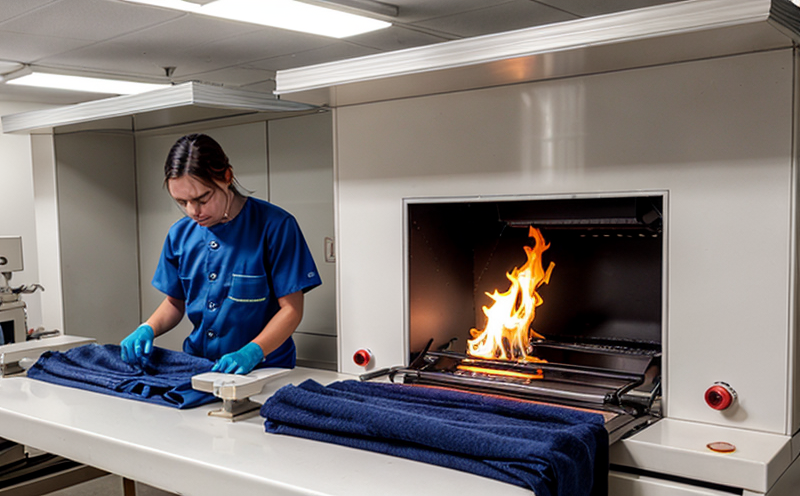BS 5438 Flammability of Fabrics for Clothing
The British Standard BS 5438 is a widely recognized and internationally respected standard specifically addressing the flammability of fabrics used in clothing. This stringent testing method ensures that textiles meet safety requirements, protecting consumers from potential hazards associated with fire risks.
Developed by the British Standards Institution (BSI), this standard has been adopted globally to ensure consistent quality and safety across various industries. BS 5438 applies primarily to fabrics intended for clothing items such as shirts, trousers, jackets, and other garments that come into direct contact with skin. The goal of this testing is to assess how a fabric behaves when exposed to an open flame or heat source.
The standard covers both static conditions (e.g., fabrics laid out flat) and dynamic conditions (e.g., fabrics in motion). It aims to simulate real-world scenarios where clothing might be exposed to ignition sources like cigarettes, flames from candles, or sparks. By adhering to this standard, manufacturers can ensure their products are safe for consumers.
One of the key aspects of BS 5438 is its emphasis on preventing the spread of fire rather than just suppressing it once ignited. This approach ensures that even if a garment catches fire due to an accidental spark or flame, it will not continue burning and cause further harm. The testing process involves placing fabric samples over a standard heat source for a specified duration under controlled conditions.
Another important feature of BS 5438 is its focus on maintaining usability after exposure to flames. Fabrics that pass this test should retain their essential properties, including strength, flexibility, and comfort, without compromising safety. This balance between performance and protection is crucial for maintaining consumer trust in the clothing industry.
Manufacturers who comply with BS 5438 demonstrate a commitment to product quality and consumer safety. By ensuring that fabrics meet this rigorous standard, they enhance their reputation among consumers and regulatory bodies alike. Furthermore, adherence to such standards can help businesses avoid costly recalls or legal issues related to unsafe products.
Understanding the specific requirements outlined in BS 5438 is essential for any company involved in producing clothing made from fabric. Compliance with these regulations not only protects end-users but also strengthens brand integrity and fosters long-term customer loyalty.
- Static Testing: Involves placing fabrics over a standard heat source, assessing the spread of flame, and measuring char length.
- Dynamic Testing: Simulates real-world scenarios by testing fabrics while in motion. This includes evaluating flammability under various conditions like walking or running.
- After-Fire Performance: Ensures that fabrics maintain their structural integrity post-exposure to flames, ensuring continued usability and safety.
In summary, BS 5438 provides a comprehensive framework for assessing the flammability of clothing fabrics. Its rigorous testing ensures both consumer protection and product performance, making it an indispensable tool for manufacturers in the textile and apparel sectors.
Scope and Methodology
The scope of BS 5438 encompasses a wide range of fabrics commonly found in clothing items. This includes natural fibers such as cotton, wool, and silk, as well as synthetic materials like polyester and nylon. The standard applies to both woven and knitted fabrics used for making garments that are likely to come into contact with the skin.
For static testing, samples are cut from fabric pieces measuring approximately 200 mm x 150 mm (8 in x 6 in) and placed over a standardized heat source. The duration of exposure depends on the type of fabric being tested; typically, it ranges between 3 to 4 seconds for synthetic materials to up to 9 seconds for natural fibers.
The dynamic testing involves simulating walking motions using a mechanical device that mimics human movement. During this process, small samples are attached to the leg of an artificial manikin and subjected to repeated bending actions while exposed to flame or heat sources similar to those encountered in daily life situations.
After each test run, detailed measurements are taken to evaluate parameters such as char length, flaming time, non-flaming droplets, and overall behavior under fire. These metrics provide valuable insights into the flammability characteristics of different fabrics and their potential risks if improperly handled or used.
In addition to these physical tests, visual inspections play an important role in determining compliance with BS 5438 standards. Observations about smoke production, heat radiation, and other visible signs help assess whether a fabric meets the required safety levels set forth by this standard.
It is worth noting that laboratories performing BS 5438 tests must possess appropriate equipment and facilities capable of recreating these controlled environments accurately. Proper calibration of instruments ensures reliable results across multiple trials conducted under identical conditions.
Benefits
Adhering to the BS 5438 standard offers numerous advantages for manufacturers, retailers, and consumers alike:
- Enhanced Consumer Safety: By ensuring that fabrics used in clothing meet stringent flammability requirements, this standard significantly reduces the risk of fire-related accidents.
- Increased Brand Reputation: Compliance with international standards like BS 5438 can enhance a company’s reputation as a leader in quality and safety.
- Avoidance of Legal Issues: Meeting regulatory requirements helps businesses avoid costly recalls or legal actions related to unsafe products.
- Better Product Quality: The rigorous testing process ensures that only high-quality fabrics are used, leading to superior garment performance and durability.
- Improved Customer Trust: Consumers appreciate brands that prioritize safety and well-being, fostering long-term customer relationships.
- Competitive Advantage: Companies that comply with international standards gain a competitive edge in the global market by demonstrating their commitment to excellence.
In conclusion, adopting BS 5438 not only enhances product quality but also contributes positively towards building stronger brands and more secure communities.





